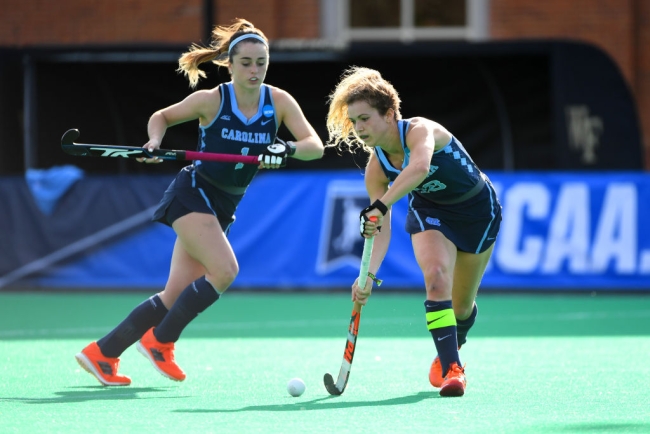You have /5 articles left.
Sign up for a free account or log in.

Jamie Schwaberow/NCAA Photos/Getty Images
I often describe myself as a Title IX baby. That is, I was born just in time to reap the benefits of the passage of Title IX of the Education Amendments of 1972. Of course, today, Title IX is mostly associated with sexual assault and sexual harassment, new rules for which were just released by the Biden administration that provide more explicit language in how we define sexual harassment and that expand protections to students based on gender and sexual identity. The rules direct our colleges in how we must investigate and punish campus sexual misconduct. Yet in its beginning, Title IX’s banning of sex-based discrimination was best known for opening collegiate opportunities to compete for women.
My first deep exposure to Title IX was in ninth grade, a few years after it passed. I wrote an essay about the topic for the high school newspaper that ended up winning bronze recognition in a competition hosted by the University of Maryland’s School of Journalism. I knew, as a three-sport athlete, that Title IX was my ticket to college. So did my parents. No one in my family, on either my mom or dad’s side, had gone on to college directly out of high school. My dad graduated with his bachelor’s degree when I was in fourth grade using the GI Bill to fund eight years of what was then labeled “night school.”
Back then college athletic programs for women were in their early stages of development. My mom and I wrote letters to the athletic directors of the handful of colleges with competitive field hockey, basketball and softball programs. Many responded. And, with my scrapbook in hand, my mom and I went on college visits trying to convince coaches that this 5'5", 95-pound athlete had the skills to be a program change maker. The University of Delaware took a chance on me. That chance opened the door to so much more for me than the hockey field.
Sometimes we underestimate the influence of our hobbies on our leadership perspectives. On the field, especially in my position as center midfielder, I learned about the importance of holding a panoramic perspective, seeing the whole field. I learned about pace, when to go slow and when to go fast. I learned about failure and recovery and that the two concepts really do go together. I learned that winning is temporary and that what stays with you are the relationships you built to get to that point of excellence. I learned about what it takes to set a play up and what it takes to finish a play—and that these are different and equally important skills.
In January, I returned to the field hockey field, not in celebration of Title IX’s 50th anniversary, but because of it. Longing for a way to fill in the seams of a discomforting last two pandemic-filled years, I followed the suggestion of two longtime and former teammates—I picked up the stick after 21 years of not playing, practiced a few times and tried out for the USA women’s masters field hockey team. In early May, I found out I made the team.
Unfortunately, however, in some Memorial Day weekend cross-training activity, I ruptured my Achilles tendon and am recovering from surgery. I will not be representing the United States at the masters World Cup competition in October in South Africa.
But I still found it to be a real learning experience to be coached again. This time, I was listening more intently to the feedback—not just to improve my play, including the need to address the gap between what my mind thinks it can do and what my body can do, but because the feedback is around life lessons. Those include:
- Remember to receive the ball with your head up, always looking for the next option.
- Carry the ball on a diagonal—it creates more space to make decisions.
- Vary your speed. The change in pace creates spontaneity and is unpredictable to the opponent.
- Demonstrate your availability. Your movement off the ball is more important than your movement with it. You must give your teammates options. They can’t advance the ball very far on their own.
These rules don’t lend themselves to a singular translation in college leadership. Rather, each rule can be used in countless ways.
For example, in advancing an institution’s strategic plan, a leader must look ahead to what’s on the horizon to identify new strategies and places where enrollments might come from or determine where the labor market is headed and what that means for workforce development programs and curricula.
Moving on the diagonal—not in a rush to the goal—is how change happens. It helps ensure that multiple perspectives inform decisions. It allows for cross-sector teams—including students, faculty, technologists, community partners and others—to have input when it comes to implementing improvements in operations, programs and policies. It ensures that necessary supports can be staged and key stakeholders are in sync as major changes are implemented, and it leaves room for midcourse corrections when changes have unintended consequences.
Similarly, varying speed is essential. There are times when leading means taking a back seat to let others move an agenda (that might not go the direction a leader would take, but the change is what is valued). But also, there are moments when execution requires key departments and players to make a series of agile moves. And even the fastest moves need to be choreographed; the most decisive moves must be the most carefully planned.
Teamwork is learned. It doesn’t happen overnight. By implementing key aspects of a master plan according to a schedule, people and departments work out challenges, become more familiar with each other, develop greater responsiveness to change and learn to operate effectively and reciprocally.
In sports, we require everyone to be open to the next move and to accurately anticipate where they can expect others to be. We often want multiple players to touch the ball in moving down the field, because it creates a sense of shared momentum and the opportunity to use talent in optimal ways. We can strike from unexpected places or turn the organization of the field to a specific advantage. The same is true within an institution. For example, building cross-sectional teams and working across boundaries helps deliver on institutional goals, improving the organization’s ability to transform that goes beyond departments and can touch the lives of every student.
And the first lesson of teamwork and leadership is that no one, especially the leader or the star player, can advance the ball very far on their own. Coalitions of groups within the institution must operate in partnership, and the institution itself must partner with others outside their boundaries, to achieve transformative goals.
As the nation celebrates the 50th anniversary of Title IX this month, I am reminded that it wasn’t just the law that opened the door for me. It was also a coach and a higher education institution that saw something in a hopeful young girl and her scrapbook and invested in who I was and could be.
If I had had the good fortune to represent the United States in South Africa this fall, I would have been proud not just to be representing my country but also to be a beneficiary of the nation’s ongoing (though sometimes halting) commitment to equity. Proud of its efforts to recognize and support new talent no matter what it looks like and regardless of age, race or ethnicity, gender, orientation, or (dis)ability.
The talent is still there. It’s up to us to continue to find it, cherish and develop it. It is up to us to do for our current and future generations of students what Title IX did for baby boomers like me.




